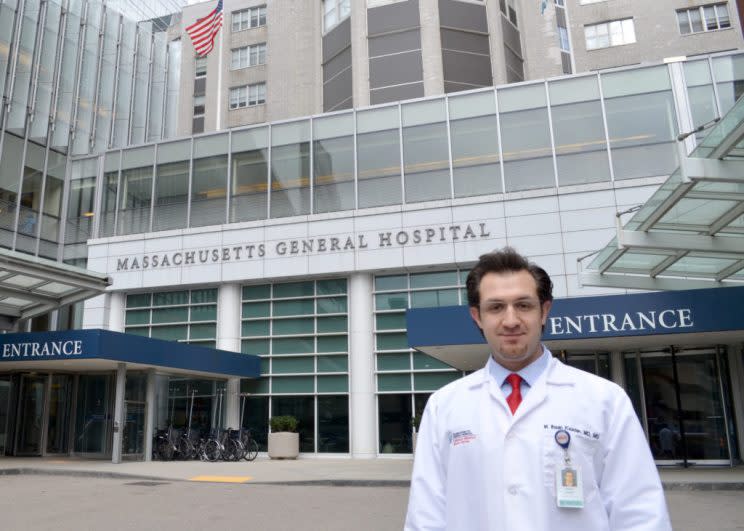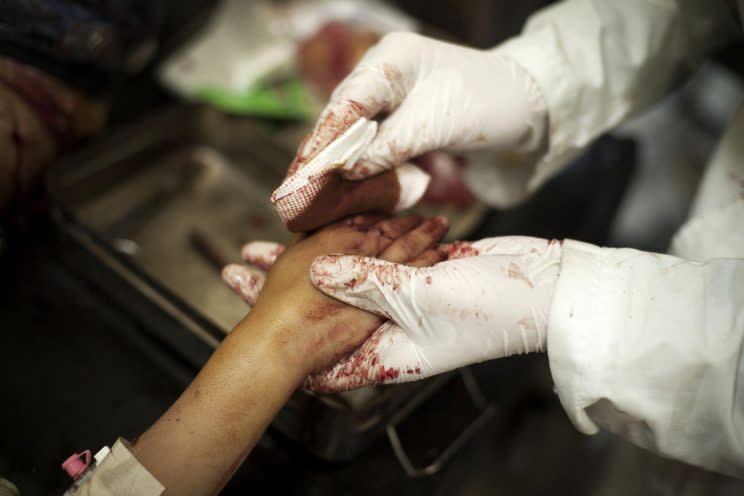Refugees in white coats: How immigration ban could affect U.S. health care

It was after the sun sank below the horizon and daylight faded into night that Ihsan Kaadan said were the worst times in Aleppo during the Syrian war. There was no electricity, so after dark, as the sound of airstrikes pierced the night, the people caught in the crossfire of war could only wait. “You would just wait to see the light again,” said Kaadan.
“It was the most hopeless time I’ve ever experienced in my life.”
Kaadan, MD, was in his last year as a medical student at the University of Aleppo in 2012 when the war began, and the city soon became the epicenter of a brutal and horrific conflict. Bombs rained down in the eastern part of the city, killing tens of thousands and forcing people who managed to survive to flee to the western neighborhoods. Many didn’t have enough money to rent homes or find adequate shelter — mosques, parks and empty buildings became places of refuge. Dozens of families suddenly filled an abandoned school near the university where Kaadan studied, so while caring for those who had been caught in the ravages of war, including children attacked by chemical weapons, he also observed the desperate need for medical care in those improvised refugee camps. He, along with a dentist and two pharmacists, soon set up a makeshift clinic in the school where the displaced families were living.
Two or three families occupied each classroom, separated by curtains. In another room was the clinic, where, for two years, Kaadan treated patients every day, even when resources were scarce and many doctors and surgeons had already fled the country.
“We often couldn’t even find antibiotics or basic tools,” said Kaadan. But despite the lack of medical equipment and medicine, he did what he could day in and day out, though it often didn’t feel like much. “Aleppo had once been a city of joy,” said Kaadan. “And it descended into chaos. It was completely heartbreaking.”
Water and food were scarce. Schools had been shut down, along with most of the city hospital too. “The humanitarian crisis there was like nothing anyone had seen,” said Kaadan. “And it was never what you’d actually see in the news.”

Kaadan knew that he’d never be able to finish his clinical training if he stayed in Syria, and his parents became more and more worried about their son’s safety. “I didn’t want to leave,” said Kaadan. But in the middle of a cold night in 2014, Kaadan’s mother and father finally got their wish: They were able to convince him it was time to go.
His parents drove him to the border of Turkey, a route that involved the “death path,” a 300-yard stretch of open road where people were randomly targeted by snipers. They heard shooting as they approached the area and knew they could be targets at any moment. But after what felt like miles, the family found itself safely on the other side. Kaadan gave his mother and father a quick goodbye — unsure of whether he’d ever see them again — and took a taxi into Turkey then a bus to the city of Istanbul, where he was able to get a flight to the United States. He then connected with his father’s friend, who is a cardiologist in rural Alabama.
Kaadan worked through his own posttraumatic stress disorder during his first months in the U.S. while caring for patients at the practice. “Whenever I saw a pickup truck coming down the street, I’d quickly go to the side to let them pass. I’d always imagine the fighters in Syria in the bed of the truck, guns in hand, shooting into the air,” he said.
Several months after arriving in the South, Kaadan received a scholarship from the Open Society Foundations, which funded his master’s degree at Brandeis University, where he studied international health policy and management. Today, he works as a cardiac researcher at Massachusetts General Hospital.
Two weeks ago, a group of physicians at Massachusetts General wrote an opinion piece in the New England Journal of Medicine (NEJM), denouncing President Trump’s initial immigration ban from seven majority-Muslim countries, and arguing that the U.S. health care system would all but fall apart with such overarching restrictions against immigrants and refugees. The nation relies heavily on foreign-born doctors, who make up 42 percent of office visits in rural America, according to the American Academy of Family Physicians. And currently, nearly 3,500 doctors from Syria are working in the U.S., according to Medicus Firm, a physician-staffing service.
While a federal court reversed Trump’s initial ruling, the president has promised to roll out a new, more streamlined executive order imposing travel restrictions on certain foreign-born immigrants. Katrina Armstrong, MD, chair of the department of medicine at Massachusetts General Hospital and one of the authors of the opinion piece in NEJM, noted that the potential restrictions have severe short- and long-term consequences for the U.S. health care system.
The short-term effects of any sort of travel ban would mostly fall on patients, trainees and training programs, said Armstrong, noting that MGH cares for many refugees and immigrants who are currently being targeted by Trump’s potential restrictions. “The stress levels in those who do come in now are extremely high, particularly those who were persecuted and suffered trauma in the countries they fled,” she said.
The uncertainty about whether medical students in other countries will be able to get new visas if they are accepted for medical residency in the U.S. has also created a major challenge, especially for many rural hospitals that depend upon residents for the delivery of care, Armstrong noted.
As for the long-term effects, Armstrong says restricting talented physicians from coming to America hinders “both the ability to deliver the best care to patients here in the U.S. and to develop new treatments and preventive strategies that can save lives and reduce suffering” and could have devastating effects on both Americans individually and the nation as a whole.
To further her point, Armstrong recalled the powerful response to the Boston Marathon bombings in 2013, when doctors across the city’s hospitals came together within minutes to care for the injured.
“Many of those doctors came to the U.S. from other countries and were able to give back to our community in ways that reflect their incredible talent and their commitment to our values,” said Armstrong, specifically noting George Velmahos, MD, the Greek-born lead trauma surgeon at MGH who has been cited for his response to the attacks and for saving the lives of two police officers who were shot in Boston last year.
Last year, Kaadan participated in the Zika Hackathon, in which he and other team members developed the larvicide automatic dispenser, a novel way to combat the Zika virus. The 28-year-old echoed those sentiments about foreign-born doctors, stressing that all he wants to do is give back to the city and country that have offered him refuge. And he hopes that his U.S. training will allow him to one day help the Syrian people “heal and rebuild their health system.”
“You will not find someone who is more motivated to get educated and to work than a refugee,” said Kaadan, who is currently in the U.S. under temporary immigration protection status and will soon apply for a J-1 visa, which is offered for cultural and educational exchange. “We are thirsty to improve. As a refugee, we have no other options other than to study and work hard. We have nothing else. It is our only path to survival.”
Read more from Yahoo News:


